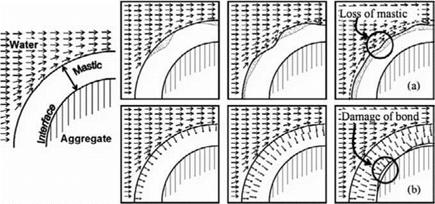The Physical Processes Contributing to Water-Induced Damage
The existence of a water flow through an asphaltic mixture may cause desorption of parts of the mastic films which are in direct contact with the water flow, Fig. 5.8(a) carrying away elements of the bitumen[8] by advection (see Chapter 6 for a fuller definition of advection). Exposure of an asphaltic mixture to stationary water (i. e. no
|
Fig. 5.8 Schematic of physical water damage-inducing processes (Kringos & Scarpas, 2005a; Kringos, 2007) (a) Loss of mastic due to advective transport (b) Damage of the bond due to water diffusion |
water flow) would, therefore, show no advective transport damage. Since practice has shown that exposure of asphaltic mixtures to stationary water does, in time, cause ravelling of the mixture, this process cannot be the only phenomenon causing water damage. In asphaltic mixtures, diffusion of water through the mastic films surrounding the aggregates is a molecular process that may eventually lead to water reaching the interface area between the mastic and the aggregates. Depending on the bond characteristics, the water can then cause an adhesive failure of the mastic – aggregate interface, Fig. 5.8b).
|
Fig. 5.9 Simulation of loss of mastic from around a coarse aggregate particle due to a fast water flow field Aggregate is omitted in Finite Element model shown in the lower part of the figure. |
As time increases, the diffusion of water through the mastic weakens the cohesive strength and the stiffness of the mastic and may actually aggravate the desorption. These are modelled using the approaches set out in Chapter 11. More details about these mathematical formulations can be found in Kringos & Scarpas (2004; 2005a & 2006), Kringos (2007) and Kringos et al. (2007). Figure 5.9 shows an example of a mastic desorption simulation with RoAM, in which a coated aggregate is exposed to a fast water flow field.








Leave a reply